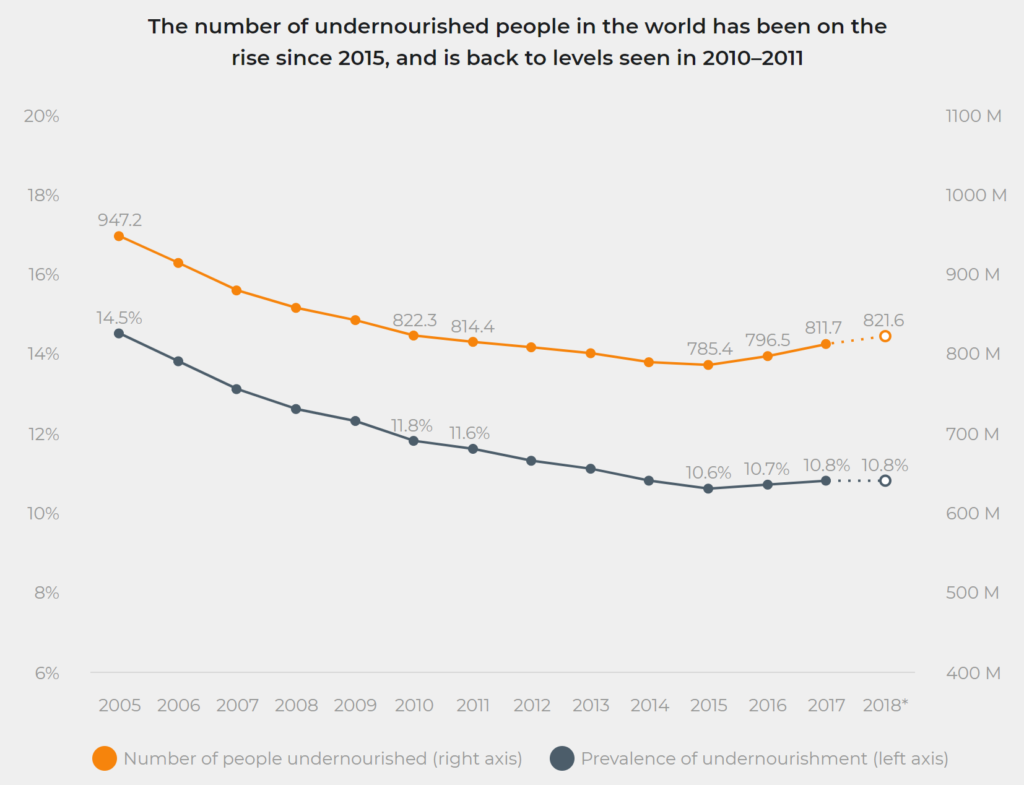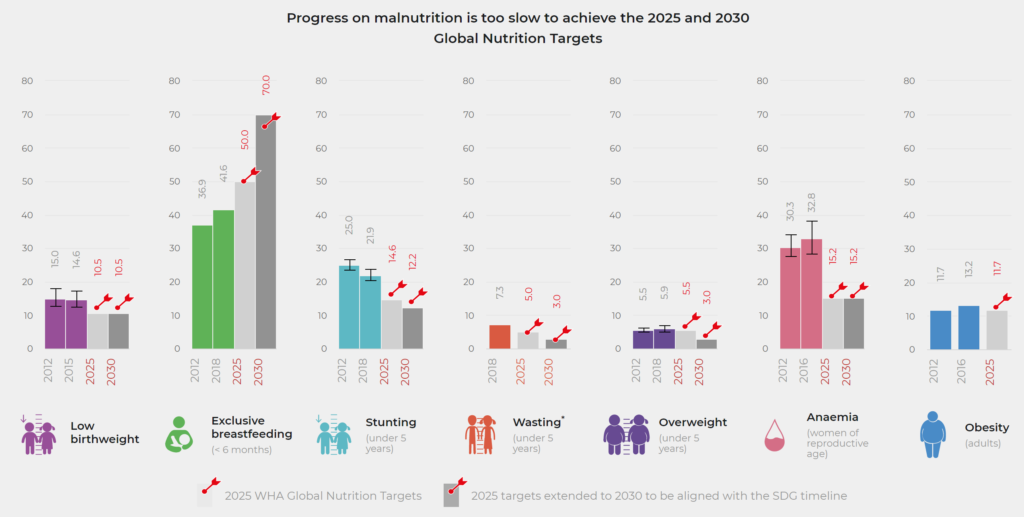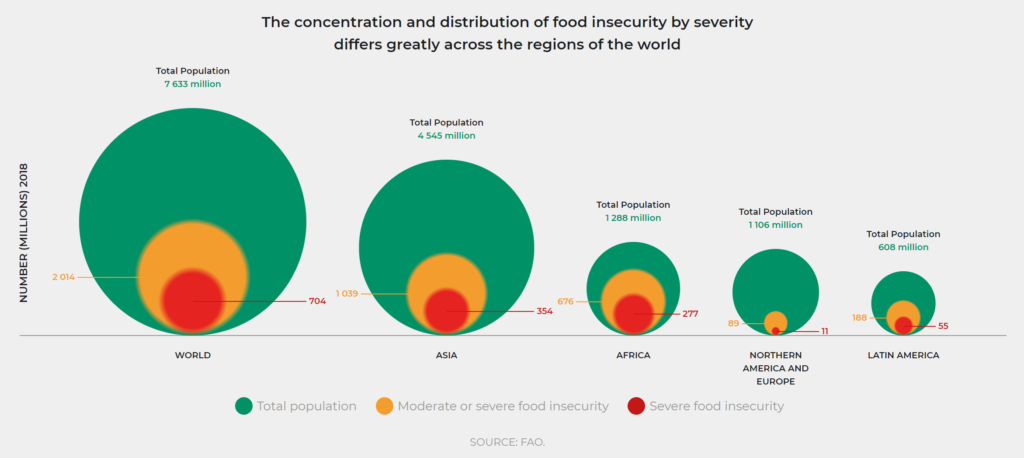Over 820 million people suffer from hunger, with number increasing for third straight year – Overweight and obesity rising in almost all countries
15 July 2019 (UN News) – After nearly a decade of progress, the number of people who suffer from hunger has slowly increased over the past three years, with about one in every nine people globally suffering from hunger today, the United Nations said in a new report released on Monday.
This fact underscores “the immense challenge” to achieving the Zero Hunger target of the Sustainable Development Goals (SDGs) by 2030, according to the State of Food Security and Nutrition in the World 2019.
The report, launched on the margins of the High-level Political Forum (HLPF) – the main UN platform monitoring follow-up on States’ actions on the SDGs – currently under way in New York, breaks down statistics by region, and shows that hunger has risen almost 20 per cent in Africa’s subregions, areas which also have the greatest prevalence of undernourishment.
Although the pervasiveness of hunger in Latin America and the Caribbean is still below seven per cent, it is slowly increasing. And in Asia, undernourishment affects 11 per cent of the population. Although southern Asia saw great progress over the last five years, at almost 15 per cent, it is still the subregion with the highest prevalence of undernourishment.
“Our actions to tackle these troubling trends will have to be bolder, not only in scale but also in terms of multisectoral collaboration,” the heads of the UN Food and Agriculture Organization (FAO), the International Fund for Agricultural Development (IFAD), the UN Children’s Fund (UNICEF), the World Food Programme (WFP) and the World Health Organization (WHO) urged in their joint foreword to the report.

Hunger is increasing in many countries where economic growth is lagging, particularly in middle-income countries and those that rely heavily on international primary commodity trade.
The annual UN report also found that income inequality is rising in many of the countries where hunger is on the rise, making it even more difficult for the poor, vulnerable or marginalized to cope with economic slowdowns and downturns.
“We must foster pro-poor and inclusive structural transformation focusing on people and placing communities at the centre to reduce economic vulnerabilities and set ourselves on track to ending hunger, food insecurity and all forms of malnutrition,” the UN leaders said.
Food insecurity
This year’s edition of the report takes a broader look at the impact of food insecurity – beyond hunger.
It introduces, for the first time, a second indicator for monitoring Sustainable Development Goals (SDGs) Target 2.1 on the Prevalence of Moderate or Severe Food Insecurity that shows that 17.2 per cent of the world’s population, or 1.3 billion people, lacked regular access to “nutritious and sufficient food”.
“Even if they were not necessarily suffering from hunger, they are at greater risk of various forms of malnutrition and poor health”, according to the report.
The combination of moderate and severe levels of food insecurity brings the estimate to about two billion people, where in every continent, women are slightly more food insecure than men.
Low birthweight still a major challenge
Turning to children, the report disclosed that since 2012, no progress has been made in reducing low birthweight.
Additionally, while the number of under-age-five children affected by stunting has decreased over the past six years by 10 per cent globally, the pace of progress is too slow to meet the 2030 target of halving the number of stunted children.
Furthermore, overweight and obesity continue to increase throughout all regions, particularly among school-age children and adults.
To safeguard food security and nutrition, the 2019 report stresses the importance to economic and social policies to counteract the effects of adverse economic cycles when they arrive, while avoiding cuts in essential services.
It maintains that the uneven pace of economic recovery “is undermining efforts to end hunger and malnutrition, with hunger increasing in many countries where the economy has slowed down or contracted”, mostly in middle-income nations.
Moreover, economic slowdowns or downturns disproportionally undermine food security and nutrition where inequalities are greater.
“Income inequality increases the likelihood of severe food insecurity, and this effect is 20 per cent higher for low-income countries compared with middle-income countries”, the report spells out.
The report concludes with guidance on what short- and long-term policies must be undertaken to safeguard food security and nutrition during episodes of economic turmoil or in preparation for them, such as integrating food security and nutrition concerns into poverty reduction efforts using pro-poor and inclusive structural transformations.

The State of Food Security and Nutrition in the World 2019
15 July 2019 (FAO) – For decades, the number of hungry people had been declining. This isn’t true anymore. More than 820 million people do not have enough to eat. At the same time, no region is exempt from the epidemic of overweight and obesity. Ending hunger and all forms of malnutrition by 2030 is an immense challenge.
The main indicator for monitoring progress on the eradication of hunger in the world reported here is the prevalence of undernourishment, or PoU (SDG Indicator 2.1.1). Beginning in 2017, the prevalence of severe food insecurity based on the Food Insecurity Experience Scale (FIES) was also included in the report as another, complementary indicator of hunger using a different approach.
This year’s report now takes a step forward by also including, for the first time, estimates of the prevalence of moderate or severe food insecurity based on the FIES (SDG Indicator 2.1.2). This indicator provides a perspective on global food insecurity relevant for all countries of the world: one that looks beyond hunger towards the goal of ensuring access to nutritious and sufficient food for all. As estimates of SDG Indicator 2.1.2 refer to the total number of people suffering from food insecurity, including at moderate levels, it should come as no surprise that they correspond to a much higher number of people than those who suffer from hunger. […]
Prevalence of undernourishment (PoU)
The two most recent editions of this report already offered evidence that the decades-long decline in the prevalence of undernourishment in the world had ended and that hunger was slowly on the rise.
Additional evidence available this year confirms that the global level of the PoU has remained virtually unchanged at a level slightly below 11 percent, while the total number of undernourished (NoU) has been slowly increasing for several years in a row. This means that today, a little over 820 million people suffer from hunger, corresponding to about one in every nine people in the world.
The situation is most alarming in Africa, where since 2015 the PoU shows slight but steady increases in almost all subregions. In Asia, the PoU has been steadily decreasing in most regions, reaching 11.4 percent in 2017. In Latin America and the Caribbean (LAC), rates of undernourishment have increased in recent years, largely as a consequence of the situation in South America.
Prevalence of moderate or severe food insecurity
The 2019 edition of the report introduces for the first time estimates of the prevalence of food insecurity combining moderate and severe levels. This indicator refers to an expanded range of food-insecurity severity that encompasses moderate levels.
According to the latest estimates, 9.2 percent of the world population (or slightly more than 700 million people) were exposed to severe levels of food insecurity in 2018, implying reductions in the quantity of food consumed to the extent that they have possibly experienced hunger.

A broader look at the extent of food insecurity beyond severe levels and hunger reveals that an additional 17.2 percent of the world population, or 1.3 billion people, have experienced food insecurity at moderate levels, meaning they did not have regular access to nutritious and sufficient food.
The combination of moderate and severe levels of food insecurity brings the estimated total to 26.4 percent of the world population, amounting to about 2 billion people.
Progress toward global nutrition targets
Malnutrition exists in multiple forms. Maternal and child undernutrition contributes to 45 percent of deaths in children under five. Overweight and obesity are on the rise in almost all countries, contributing to 4 million deaths globally. The various forms of malnutrition are intertwined throughout the life cycle, with maternal undernutrition, low birthweight and child stunting giving rise to increased risk of overweight later in life.
This section assesses global and regional trends and patterns to track progress towards seven nutrition indicators used to monitor global World Health Assembly targets for nutrition.
Global and regional trends
Low birthweight estimates indicate that one in seven live births, or 20.5 million babies globally, suffered from low birthweight in 2015. If current trends continue, the 2025 World Health Assembly target of a 30 percent reduction in the prevalence of low birthweight will not be met. […]
In 2018, childhood overweight affected 40.1 million children under five worldwide; while in 2016, nearly two in five adults (38.9 percent) were overweight, representing 2 billion adults worldwide. The prevalence of overweight is increasing in all age groups and in all regions.
A closer look at the SDG indicators of wasting, stunting, and childhood overweight reveal striking regional differences. In 2018, Africa and Asia bear the greatest share of all forms of malnutrition by accounting for more than nine out of ten of all stunted children, over nine out of ten of all wasted children, and nearly three-quarters of all overweight children worldwide. [more]


